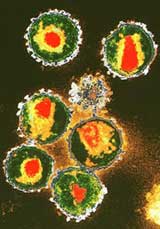AIDS vaccine delivers

The HIV virus: killing cells laden with these particles may form a key part of future AIDS vaccination strategies. <br>© SPL <br>
Cellular attack tactic keeps virus at bay.
A new AIDS vaccine could be one of the most promising yet. The drug’s effects in monkeys suggest that killing virus-laden cells may form a key part of future vaccination strategies.
Vaccinated monkeys survived a usually lethal infection with a monkey-human hybrid virus, SHIV. Their primed immune system kept virus levels below detection, Emilio Emini of Merck Research Laboratories in West Point, Pennsylvania, and his team now report1. The results are some of the most encouraging to come out of AIDS vaccine research.
But doubts have already been voiced. Low-lying virus can change to elude the immune response, argue Dan Barouch of Harvard Medical School in Boston and his team. A year after they gave eight animals a similar vaccination, a mutant form of the virus emerged, killing one of the monkeys2.
“This finding should be a reality check rather than a death knell,” Barouch says, adding that the technique can be modified to block the emergence of mutant viruses. Future attempts could hit several different SIV proteins to prevent the virus escaping. Both of the latest vaccines targeted a single protein.
Emini is already pursuing this goal. But like multi-drug-resistant bacteria, HIV could conceivably outwit even a broadly targeted vaccine, although this is less likely. Whether the vaccines tested in the monkeys will be as effective in humans, however, is unknown.
Troubled history
AIDS is notoriously difficult to vaccinate against. Initial attempts took a conventional approach by injecting a single HIV surface protein to trigger the animals’ immune system into producing antibodies that would attack the virus during a subsequent infection. But HIV evades antibodies by hiding the proteins that the antibodies latch onto and by evolving new strains.
“HIV turned out to be much more complicated,” says vaccine researcher Jeffrey Lifson of the National Cancer Institute at Frederick, Maryland. In the past few years, vaccine hunters have switched to a different tack that simulates the way the body naturally attempts to deal with HIV infection – namely, stimulating the immune system to strike virus-infected cells.
Emini’s team achieved this by using a harmless virus to deliver SIV DNA direct to specific immune cells. “It looks encouraging,” says Lifson.
Unfortunately, as with any vaccine that keeps virus levels in check, rather than preventing infection, there is the risk that the pathogen will re-emerge. “It’s an ominous question to ask about the whole strategy,” comments Lifson. Nonetheless, such a vaccine could in theory defer the onset of AIDS and cut the risk of HIV spreading.
The antibody approach may still bear fruit if it can hit essential, unchanging parts of the virus. Meanwhile, the ultimate ideal remains a vaccine that triggers both arms of the immune system – antibodies and cell attack.
References
- Shiver, J. W. et al. Replication-incompetent adenoviral vaccine vector elicits effective anti-immunodeficiency-virus immunity. Nature, 415, 331 – 335, (2002).
- Barouch, D. H. et al. Eventual AIDS vaccine failure in a rhesus monkey by viral escape from cytotoxic T lymphocytes. Nature, 415, 335 – 339, (2002).
Media Contact
All latest news from the category: Health and Medicine
This subject area encompasses research and studies in the field of human medicine.
Among the wide-ranging list of topics covered here are anesthesiology, anatomy, surgery, human genetics, hygiene and environmental medicine, internal medicine, neurology, pharmacology, physiology, urology and dental medicine.
Newest articles

Webb captures top of iconic horsehead nebula in unprecedented detail
NASA’s James Webb Space Telescope has captured the sharpest infrared images to date of a zoomed-in portion of one of the most distinctive objects in our skies, the Horsehead Nebula….

Cost-effective, high-capacity, and cyclable lithium-ion battery cathodes
Charge-recharge cycling of lithium-superrich iron oxide, a cost-effective and high-capacity cathode for new-generation lithium-ion batteries, can be greatly improved by doping with readily available mineral elements. The energy capacity and…

Novel genetic plant regeneration approach
…without the application of phytohormones. Researchers develop a novel plant regeneration approach by modulating the expression of genes that control plant cell differentiation. For ages now, plants have been the…





















